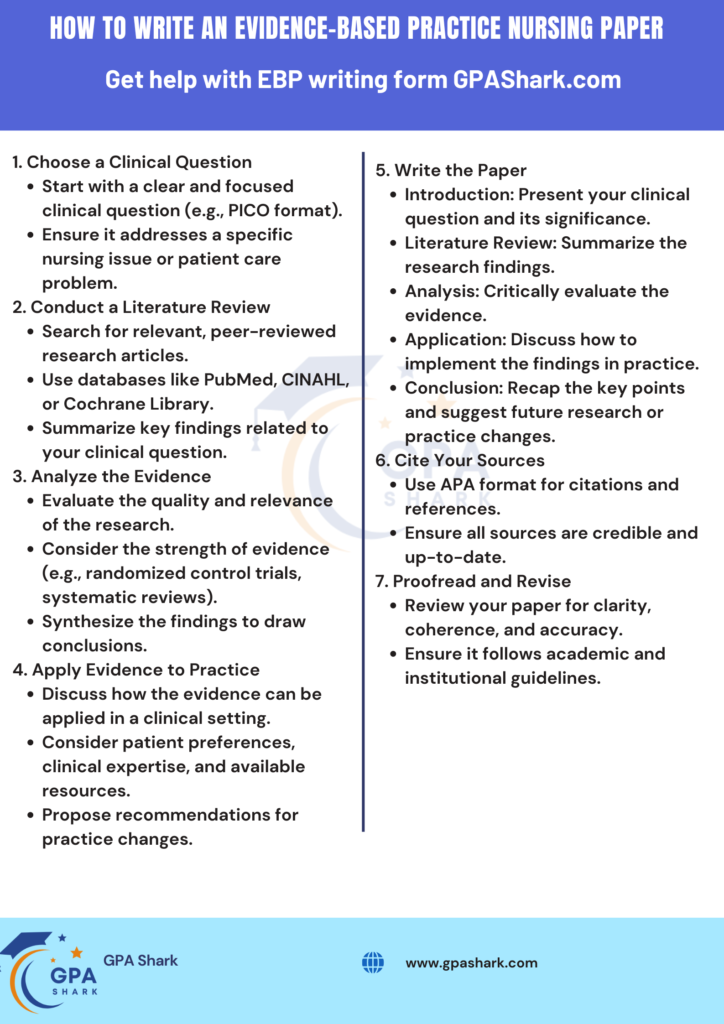Writing an evidence-based practice nursing paper is a critical task that bridges the gap between research and clinical practice. An EBP paper demonstrates a nurse’s ability to apply research findings to patient care, enhancing the quality and effectiveness of nursing interventions. This guide will walk you through the key steps to craft a well-structured, impactful EBP nursing paper.
Table of Contents
What is an Evidence-based Practice Nursing Paper?
An Evidence-Based Practice (EBP) Nursing Paper is a scholarly document that focuses on applying the best available research evidence to clinical nursing practice. The primary goal of an EBP nursing paper is to improve patient care by integrating clinical expertise with the most current and relevant research, along with considering patient preferences and values.
The purpose of an EBP nursing paper is to ensure that nursing interventions and decisions are based on the best available evidence, leading to higher-quality care, improved patient outcomes, and more efficient healthcare practices. It is a critical tool for advancing nursing practice by bridging the gap between research and clinical application.

7 Steps on How to Write an Evidence-Based Practice Nursing Paper
1. Understanding the Purpose of Evidence-Based Practice
Before you begin writing, it’s essential to understand the purpose of EBP in nursing. EBP integrates clinical expertise, patient preferences, and the best available evidence to make decisions about patient care. Your paper should showcase how these elements come together to improve outcomes.
2. Choosing a Relevant Topic
Select a topic that is both relevant to your field and of interest to you. The topic should address a current issue or gap in nursing practice that can be informed by evidence. Common areas for EBP topics include patient safety, infection control, pain management, and chronic disease management.
Example Topics:
- The impact of hand hygiene protocols on hospital-acquired infections.
- The effectiveness of patient education in managing diabetes.
- Pain management strategies in postoperative care.
3. Conducting a Literature Review
A comprehensive literature review is the backbone of your EBP paper. It involves identifying, evaluating, and synthesizing existing research related to your topic. Use credible databases like PubMed, CINAHL, and Cochrane Library to gather peer-reviewed articles, clinical guidelines, and meta-analyses.
Steps for a Successful Literature Review:
- Search: Use keywords related to your topic to find relevant studies.
- Evaluate: Critically assess the quality and relevance of each study.
- Synthesize: Identify common themes, gaps in the research, and the strength of the evidence.
4. Developing a Clinical Question Using PICO
The PICO (Population, Intervention, Comparison, Outcome) framework helps you formulate a focused clinical question, guiding your literature search and paper structure.
Example PICO Question:
- P: Patients with chronic obstructive pulmonary disease (COPD)
- I: Implementation of a smoking cessation program
- C: Standard care without a smoking cessation program
- O: Reduction in COPD exacerbations
5. Structuring Your EBP Nursing Paper
A well-organized paper enhances readability and ensures that your arguments are clear. Here’s a typical structure:
a. Introduction
Introduce your topic, provide background information, and explain the significance of the issue. Clearly state your clinical question and the purpose of your paper.
b. Literature Review
Present a summary of the research you’ve reviewed. Highlight key findings, noting any inconsistencies or gaps in the evidence. Discuss how the evidence supports or contradicts current practices.
c. Discussion
Analyze the implications of the evidence for nursing practice. Discuss how the evidence can be integrated into clinical practice to improve patient outcomes. Address any potential barriers to implementation and suggest strategies to overcome them.
d. Conclusion
Summarize the main points of your paper. Restate the importance of EBP in nursing and the potential impact of your findings on patient care.
e. References
Cite all the sources you used in your paper following the APA format. Ensure your references are recent and from credible sources.
6. Writing the Paper
When writing your paper, maintain a clear and professional tone. Use evidence to support your claims and ensure that your arguments flow logically. Be concise and avoid unnecessary jargon.
7. Conclusion
Writing an EBP nursing paper requires careful planning, research, and writing. By following these steps, you can produce a well-structured, evidence-based paper that contributes to nursing practice and patient care. Remember, the goal of EBP is to bring research into practice, ensuring that nursing care is based on the best available evidence.
With a strong EBP paper, you not only demonstrate your understanding of current research but also show your commitment to improving patient outcomes through informed, evidence-based nursing practice.
Get Professional Help Evidence-Based Practice Nursing Paper Here!
Looking for expert assistance with your Evidence-Based Practice (EBP) Nursing Paper? You’re in the right place! At GPAshark.com, we offer professional writing help tailored to your specific needs. Whether you’re struggling with formulating a clinical question, conducting a thorough literature review, or applying evidence to practice, our experienced team is here to guide you every step of the way.
Let us help you achieve excellence in your nursing assignments. Get started with GPAshark.com today and elevate your nursing practice with a well-crafted, evidence-based paper!
FAQs on Getting Professional Help with Evidence-Based Practice Nursing Papers at GPAshark.com
What is an Evidence-Based Practice Nursing Paper?
An Evidence-Based Practice (EBP) Nursing Paper is a research-based assignment that requires nursing students to explore clinical questions, review relevant literature, and apply evidence to improve patient care outcomes. It typically involves integrating research findings with clinical expertise and patient preferences.
How can GPAshark.com help with my Evidence-Based Practice Nursing Paper?
GPAshark.com provides expert writing assistance, helping you through every stage of your EBP paper. Our team can assist you in developing a clinical question, conducting a thorough literature review, analyzing research findings, and applying them to nursing practice. We ensure your paper is well-organized, properly cited, and meets academic standards.
Are your writers experienced in nursing and healthcare topics?
Yes, our team consists of experienced writers with a strong background in nursing and healthcare. They are familiar with the latest research and evidence-based practices, ensuring that your paper is not only accurate but also relevant to current nursing standards.
Can GPAshark.com help with selecting a topic for my EBP Nursing Paper?
Absolutely! If you’re unsure about selecting a topic, our experts can help you choose a relevant and impactful subject for your EBP paper. We consider factors such as your area of interest, clinical relevance, and the availability of research evidence.
How do I get started with GPAshark.com for my EBP Nursing Paper?
Getting started is simple! Visit GPAshark.com, fill out our order form with your assignment details, and our team will begin working on your Evidence-Based Practice Nursing Paper. If you have specific requirements or guidelines, be sure to include them, and we’ll ensure your paper meets your exact needs.
Must Read:

